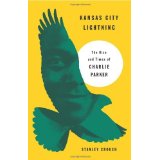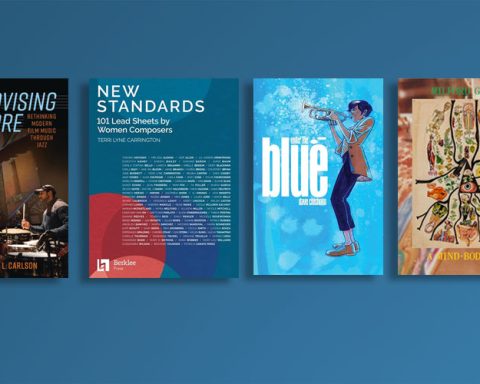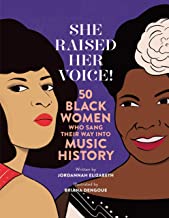Kansas City Lightning: The Rise and Times of Charlie Parker, by Stanley Crouch  Harper Collins, © 2013 by Stanley Crouch; 365 pp; $53.31 hardcover; $12.74 Kindle edition
Harper Collins, © 2013 by Stanley Crouch; 365 pp; $53.31 hardcover; $12.74 Kindle edition
By Peter Gerler
I’ve never been a Bird lover — for no good reason other than that his playing feels cool, detached, even saucy. It lacks the breathy soul of a Ben Webster or the warm allure of a Lester Young. In his lightning-fast runs, Bird seems trying to get somewhere but not satisfied with where he is.
Was he trying to draw attention, make a noise — be somebody? My home terrain is early jazz — out of New Orleans and Chicago in the ’20s and ’30s, when swing came rolling and stomping, changes arrived like new days, and the band was the star. As the street-style Chicago guitarist Eddie Condon said of the beboppers, “They flat their 5ths; we drink ours.”
But in his down-home, cut-to-the-bone new book, Kansas City Lightning: The Rise and Times of Charlie Parker—the first of two volumes–Stanley Crouch helps me see. He quotes an old-line observer of the King Oliver Band in Chicago, talking about musicians:
“’You wanted to be known by your name, not ‘that nigger over there.’ To be an individual was the most important thing in the world to you….Somebody would get mad at all the attention some other sumbitch was getting. He would get as green with jealousy as your finger does if you wearing a cheap ring. All he can think about is, How can I get some attention?’”
Now I begin to understand. We are all lonely. And if you’re black, you’re marked down. Louis Armstrong said it: his New Orleans musical running buddies “all had that little inferiority complex.” Racism wanted to turn them into no-counts. ‘
So to stand out in front, Bird tried a new approach. As Crouch relates, “One of Charlie’s goals had been to refine his tone, to get rid of that…vibrato and create a sound that was built for speed.” He adds that “In the pure universe of musical tone,” Bird wanted what his colleagues wanted: “to express themselves as exactly who they were….”
Jazz music, with its cohesive swing, was a way for descendants of freedmen to pull themselves out of purgatory—to “blow their horn” and find a place in the sun. It had been going on since slaves began riffing on work songs, turning subjugation into salvation. On the streets of New Orleans, the parade beat could cut through the heat—although the brass band players, sometimes marching all day, were known to collapse in the street. But they played on, chasing what Sidney Bechet called that “long song”—“a way of telling, a way of remembering something that has to be remembered.”
Charlie Parker wanted desperately to remember, and for years he practiced into the night to reach the goal. He was after a sound—not just a tone, but a dust storm of timbre and harmonic delight, notes piercing the sky. Not just the long song, but every melody he heard along the way, every unexplored corner, all of it birdsong.
Covering Parker’s early days (Crouch has reserved Bird’s peak years for the second volume), Kansas City Lightning is a story of love forsaken for a dream realized—setting aside this world for one conjured. It is a story of hearing yourself and knowing you’ve got something to sell—in a marketplace thick with voices.
In Charlie Parker’s instance, that marketplace was Kansas City, Missouri, where anarchy was served as part of one’s daily portion. “In the nineteenth century,” writes Crouch, “when Americans thought of the Wild West, they didn’t mean California….They were thinking of towns just west of the Missouri River, towns in Kansas like Dodge, Abilene, Wichita, Ellsworth. If a drunk got on a train and asked to be taken to hell, it was said, the conductor would put him off in Dodge City.”
Half a century later, in Parker’s day and under the corrupt regime of Mayor Tom Pendergast, Kansas City’s “whiskey, women, cards, and pistols” morphed into duels between rival bands, “terrors from the territories,” to paraphrase Crouch. They would come at each other to drive the challenger to the ground—horn screeches and drum beats puncturing the air like bullets.
Another American battle comes to mind: football. A man takes the pigskin and runs toward the goal. At some point, he likely gets taken down. But: Is the opposition running into him, or is he running into the opposition?
Charlie Parker’s world came full of opposition—musical mountain peaks, starting with the Cherry Blossom club in downtown K.C., where a teenage Parker peered in and heard the strange sounds inside. Later at the High Hat, guys a few years older ushered him off the stage for playing Honeysuckle Rose—one of only two songs he knew—while they went into Body and Soul. “’They laughed so hard it broke my heart,’” Parker recalled.
The opposition already stood in place when Bird came honking. Walter Page’s rhythm-tight Blue Devils had been barnstorming the territories since Parker was five years old, driven by Page’s exploratory, in-the-pocket bass excursions. As Crouch puts it, the band “had developed a reputation by the late 1920s for musically removing the scalps of the opposition and leaving their bodies for the buzzards.” This development swelled into the storm known as Kansas City swing, its riffs rolling like waves, pushing Bennie Moten’s Orchestra and, later, the Count Basie Orchestra, into the national forefront.
It was this legacy that lit the fire under Parker—as it might have under anyone with ears to hear. And in those days—beginning in earnest during Reconstruction—blacks had plenty ears, because music was salvation, taking them from the death of bondage into a life of stand up and holler, where “glamour, grace, and audacity could ramble from your instruments,” Crouch intones.
Parker chased after what Crouch has called the Negro “elite identity”—the brass band strut that New Orleans blacks had pulled from the hat after slavery, their high-brow concert pieces ringing and pounding down Canal Street in the faces of white folks who thought such music “was played only by illiterate Negroes,” as the drummer Baby Dodds recalled.
Charlie Parker practiced for all hours, until the neighbors almost asked the family to move. “They said I was driving them crazy with the horn. I used to put in at least from eleven to fifteen hours a day,” he said. He went after it like a cat after a rat— dogging what he heard on the street and in his own beat. He had to follow every highway, byway, and bye-bye way, touch every button—every note a feeling, every feeling a note. He had to hit bottom.
Which is what he did the day he left his young wife, Rebecca, after nights on end playing out, then drugged out on the edge of the city, and hopped a long freight to Chicago, riding the night into day. In Kansas City, he had played up and down the scales and the streets. Now he had hocked his horn for road cash. As Crouch writes, “…he didn’t have a saxophone now. He didn’t even have an address.”
Bird knew he needed help, and he got it—in great part from the multi-instrumentalist Buster “Prof” Smith, who had come up to Kansas City via the Oklahoma City Blue Devils, with stake-in-the-ground talent, chops, and control: he would stretch out only when he felt it would serve. “’He wasn’t one to chase after anything,’” Crouch quotes Jay McShann. “’No, Prof just laid it back cool.’” But like Bird, he worked into the night—composing and arranging for the Blue Devils, later taking on Parker as a disciple. “In Charlie, Smith found himself with a musical son,” Crouch writes. “Wherever Smith was, Parker was sure to come.”
There is a family tradition in jazz. New Orleans’ social aid and pleasure clubs brought blacks together, post-bellum, in “extended” families that put brass bands on the street almost every day, flying their colors. Lester Young came up in his dad’s family band. Joe Oliver mentoring young Louis “Dipper” Armstrong becomes a prime example of musical family: Louis’ father had abandoned his wife and two small children, and Oliver was the only musician in a family of half-siblings. Oliver and Armstrong needed each other as surrogate father and son. Perhaps it was the same for Smith and Parker, who had no siblings. One thing has surfaced through Crouch’s work: At some point, Parker started calling Smith “Dad.”
Parker would have learned something about swinging from Buster Smith, because in Oklahoma City, where Smith had joined the Blue Devils at the band’s inception, “’something was happening to the rhythm of the music,’” Ralph Ellison told Crouch. “’Not only did we hear it, we saw it, because you listened to the band swing the dancers and watched the dancers swing the band. It happened all the time…and old Buster Smith was right up there in the middle of it….”
At last, it was the Oklahoman Jay “Hootie” McShann who became Bird’s train into the “big town.” The two players were just four years apart in age, and in 1938, McShann “was just a man who had come into Kansas City after roaming the territories in second-string bands….” Parker first heard the older man in a 1938 K.C. band battle. Observes Crouch, Hootie “knew how to get down into the cracks of the blues, using a groove so rich it popped the right notes out like slices of bread in a toaster.”
McShann declined to take on Parker at first, because his drug habit had given him a rickety reputation. But in the end, Bird played with McShann on and off for four years, in Kansas and New York, laying down his first band solos with Hootie in Wichita, 1940. With McShann’s band, Bird would connect with John Birks Gillespie and Thelonious Sphere Monk, finally getting his just desserts.
But even in New York, the mountain peaks stood there for Bird. His friend, the guitarist Biddy Fleet, recalled that Parker was getting poor audience reception at first. “’Bird would take his horn and go up to the mike or go out under the spot and play and play and play. But when he finished playing, the audience…you’d see one look at the other as if, “Well, he’s finished. Who else is going to blow?” No applause, not any at all.’”
In a way, Charlie Parker’s travels from KC to New York paralleled the laying of railroad track that tied the country together. Jazz music moved—indeed, it came from motion. Charlie Parker was part of that motion, from the rhythms of Africa through the Inventions of Bach to the tunes of Broadway. He moved within himself, from one unknown place to another. There’s a change in the weather, a change in the sea, from now on there’ll be a change in me….
There was a change in me, too, when I finally heard Bird play with McShann’s band—amidst the hard-rock swing where he grew. Now, Bird conjures the image of a flowering plant with way more blooms than anyone else in the garden—or a bee flitting around, looking for that nectar. To use a New York stride term, I hear Bird shouting.
But most critical, I hear Bird swing in a way not possible with his small groups. He had to, “stretched out like that, with the rhythm section after his scalp…” as Crouch lays down. With McShann, the spine of Bird’s swing stands up like a body risen from the coffin. Recalled his old running buddy Gene Ramey, “’Bird knew how to dance in and out of that meter with the tempo, and still get back when Mama comes home for dinner.’”
In a November 2013 interview with Tavis Smiley, Crouch said, “What (Bird) was always trying to do was, as Rebecca said, he was trying to get himself audible to you. The way he was, the person that he really was, he wanted you to hear that when he was playing.”
I believe I have heard.
[PG: with valued assistance from Virginia Schaefer.






A fine review, Peter. Apropos the individual sound Bird sought, I am reminded of his oft-quoted “If you don't live it, it won't come out of your horn.” As for the continuum of jazz from its beginnings to today that he was an integral contributor to (“Parker chased after . . . the brass band strut that New Orleans blacks had pulled from the hat.”), I recall reading years ago of a scene at a gig in a club in Copenhagen, to wit, early New Orleans-style expatriate clarinetist Albert Nicholas with tears streaming down his face as he sat at table digging what avant-gardist Albert Ayler was laying down.